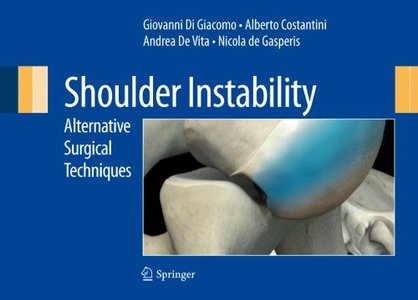博文
研学<Shoulder Instability: Alternative Surgical Techniques>
|||
研学《Shoulder Instability: Alternative Surgical Techniques(2011)》,收益良多。
随着越来越多的肩关节不稳的患者来我处寻求帮助,自感自己处理肩关节不稳相关的的理论和技术还不能完全满足患者的需要,为提高自己的能力,近日仔细研读了意大利肩关节专家Giovanni Di Giacomo等于2011年出版的肩关节不稳专著《Shoulder Instability: Alternative Surgical Techniques》(肩关节不稳:可供选择的几种手术方法)。加深了自己对肩关节不稳、肩关节脱位的发病机理、解剖学特点、影像学特点、多种手术方法的选择要求、手术技术细节与陷阱预防等相关的内容的认识。为更好地为肩关节不稳、肩关节脱位的患者更好地提供服务打下了基础、必将更好地指导自己的肩关节临床实践工作。
CHAPTER 1 – GLENOID TRACK 肩关节盂轨迹
1.1 Classification of Shoulder Instability 肩关节不稳的分类
1.2 Algorithm of Treatment 治疗流程
1.3 Hill-Sachs Lesion Hill-Sachs 损伤
1.4 Surgical Indication for Hill-Sachs Lesion Hill-Sachs 损伤的手术适应症
1.5. Glenoid Track 肩关节盂轨迹
1.5.1 A New Concept 一个新的概念
1.5.2 Glenoid Track in Cadaveric Shoulders 尸体上的肩关节盂轨迹
1.5.3 Glenoid Track in Live Shoulders 活体上的肩关节盂轨迹
1.5.4 Clinical Application 临床应用
1.6 Surgical Procedures for Hill-Sachs Lesion Hill-Sachs 损伤的手术步骤
References 参考文献
CHAPTER 2 – SHOULDER INSTABILITY: GLENOID AND HUMERAL-HEAD BONE DEFECT
2.1 Introduction
2.2 Glenoid-bone Defect
2.2.1 CT Examination Technique
2.3 Humeral Bone Loss
2.4 Conclusion
References
CHAPTER 3 – LATARJET PROCEDURE: THE MINIPLATE SURGICAL TECHNIQUE
3.1 Introduction
3.2 Patient Selection
3.3 Imaging
3.4 Surgery
3.4.1 Exposure Technique
3.4.2 Coracoid Osteotomy
3.4.3 Coracoid Preparation
3.4.4 Coracoid Preparation
3.4.5 Coracoid Preparation
3.4.6 Splitting the Subscapularis Tendon
3.4.7 Capsulotomy
3.4.8 Glenoid Preparation
3.4.9 Glenoid Preparation
3.4.10 Glenoid Preparation
3.4.11 Miniplate (Wedged Profile Plate)
3.4.11.1 Plate Technique
3.4.11.2 Plate Technique
3.4.12 Final Result
References
CHAPTER 4 – DOUBLE-ROW CAPSULOLABRAL REPAIR
4.1 Introduction
4.2 Preoperative Evaluation
4.3 Treatment Algorithm
4.4 Surgical Technique
4.5 Postoperative Rehabilitation
4.6 Conclusion
References
CHAPTER 5 – THE J-BONE GRAFT FOR ANATOMICAL RECONSTRUCTION OF GLENOID DEFECTS
5.1 Introduction
5.1.1 Classification of Instabilities
5.2 General Indications for Treating Shoulder Instability with Conservative and Surgical Techniques
5.3 Algorithm and Indications for Determining Surgery Type and Timing
5.4 Indications for the Authors’ Technique
5.5 Contraindications
5.6 Surgical Technique
5.6.1 Preoperative Workup
5.6.2 Superficial Preparation
5.6.3 Subscapularis Incision
5.6.4 Glenoid Presentation
5.6.5 Harvesting the Graft
5.6.6 J-bone-graft Modelling
5.6.7 Glenoid Osteotomy
5.6.8 Graft Positioning
5.6.9 Closing the Wound
5.7 Postoperative Care
References
CHAPTER 6 – ILIAC-CREST GRAFT AND DISTAL TIBIA ALLOGRAFT PROCEDURE
6.1 Introduction
6.2 History
6.3 Examination
6.4 Imaging
6.5 Management and Surgical Decision Making
6.6 Iliac-crest Graft Technique
6.6.1 Surgical Procedure
6.6.1.1 Patient Positioning
6.6.1.2 Incision and Approach
6.6.1.3 Subscapularis Management
6.6.1.4 Glenoid Preparation
6.6.1.5 Iliac-crest Graft
6.6.1.6 Iliac-crest Graft Placement and Closure
6.7 Distal Tibia Allograft Technique
6.7.1 Surgical Procedure
6.7.1.1 Patient Positioning
6.7.1.2 Incision and Approach
6.7.1.3 Anterior Glenoid Preparation
6.7.1.4 Distal Tibia Allograft Preparation
6.7.1.5 Distal Tibia Allograft Placement and Closure
References
CHAPTER 7 – TREATING RECURRENT ANTERIOR GLENOHUMERAL INSTABILITY USING AN AUTOGENOUS TRICORTICAL ILIAC-CREST BONE GRAFT: EDEN-HYBBINETTE PROCEDURE
7.1 Introduction
7.2 Surgical Technique
7.2.1 Patient Positioning
7.2.2 Deltopectoral Approach: Incision
7.2.3 Deltopectoral Approach: Interval Opening
7.2.4 Subscapularis Tendon Split
7.2.5 Capsulotomy
7.2.6 Exposing the Glenoid (1)
7.2.7 Exposing the Glenoid (2)
7.2.8 Glenoid Defect Measurement
7.2.9 Autologous Anterior Iliac-crest Bone Graft: Incision
7.2.10 Anterior Iliac-crest Bone Graft Harvest
7.2.11 Placement and Fixation of the Anterior Iliac-crest Bone Graft
7.2.12 Remodeling the Anterior Iliac-crest Bone Graft
7.2.13 Capsule Repair and Closure
7.3 Postoperative Treatment
7.4 Critical Concepts
7.4.1 Indications
7.4.2 Contraindications
7.4.3 Pitfalls
7.4.4 Authors’ Update
References
CHAPTER 8 – FOCAL RESURFACING OF HUMERAL-HEAD DEFECTS
8.1 Introduction
8.2 Indication/Algorithm
8.3 Technique: Humeral-head Resurfacing with Artificial Implant
8.4 Technique: Humeral-head Allograft
8.5 Postoperative Rehabilitation
8.6 Complications
8.7 Clinical Results
References
高绪仁:每天以解决膝、肩关节问题为乐:)
每天努力提高自己的技术和服务水平
https://blog.sciencenet.cn/blog-394169-615231.html
上一篇:2012年9月21周五高绪仁膝肩关节、关节镜、运动创伤门诊接诊33人
下一篇:20120922高绪仁参加同济大学程飚肩膝关节镜运动创伤手术操作学习
